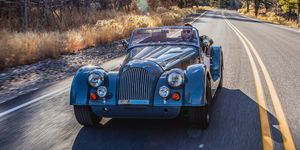- The Plus Four is Morgan’s second new sports car built on a new aluminum architecture.
- It has a BMW-sourced 2.0-liter turbocharged engine with 255 horsepower and offers either a manual or an automatic transmission.
- Morgan plans to start selling it in the U.K. this year, and says that plans for U.S. are “well advanced.”
Many new models have to replace a much-loved predecessor, but the new Morgan Plus Four faces a unique challenge: superseding a forerunner that was sold in barely altered form for no fewer than 69 years. Which is why we are not surprised that, despite sitting on an all-new platform and getting a modern BMW turbo engine, the new Plus Four looks so similar to the Plus 4 it replaces.
Visually, the two cars are close enough to be practically indistinguishable to any but the most dedicated Morgan-spotter. Compare the new model to the car we drove in California last year to see what we mean. Both generations use hand-formed aluminum bodywork over a non-structural forming frame made of ash timber. Like every other Morgan, the Plus Four will be assembled by hand at the company’s Malvern factory in England. Yet beneath the surface, the new model is almost entirely new, sitting on the new aluminum platform (dubbed CX) that the company launched with the larger Plus Six last year.
That means the sort of technical upgrades that most automakers spread out over decades have been done all at once. The Plus 4’s steel chassis has been replaced with a new bonded aluminum one, which is much stronger and sturdier yet weighs just 213 pounds. The Plus Four gains control arms at each corner, replacing the old one’s leaf-spring suspended live rear axle and sliding pillar front arrangement—a suspension system that was anachronistic even when the car was launched in 1950.
The new car has followed the Plus Six’s lead into BMW power, in this case the 2.0-liter turbocharged four-cylinder engine producing 255 horsepower. This means a new option for buyers of a four-cylinder Morgan: an automatic gearbox, the same ZF eight-speed unit used in many BMW applications. But unlike the auto-only Plus Six, Morgan will still be offering the Plus Four with the six-speed manual transmission that is likely to suit the character of the car far better.
Selecting the manual will mean making sacrifices. It has less torque than the automatic version—258 lb-ft compared to 295 lb-ft—and is both fractionally heavier and slightly slower. According to Morgan’s numbers, the stick-shift model is 9 pounds heavier than the automatic. The company claims a 4.8-second zero-to-62-mph time with the automatic gearbox and a 5.2-second time with the manual, with both cars having the same 149 mph top speed. Smaller-engined Morgans have always been impressively frugal, and economy remains a strength of the new car, with both versions scoring the equivalent of 33 mpg on the European WLTP testing protocol.
The cabin continues with Morgan’s tradition of timber and leather, although upgrades include a small digital display screen behind the steering wheel, LED interior lighting and even the option of heated seats (buyers of earlier Morgans would just put on another layer of tweed). Air vents have also arrived, an omission in the Plus 4 that could be forgiven on the basis that the car was launched before they were first invented. There is even the option of a (mostly hidden) audio system with Bluetooth connectivity.
The Plus Four is designed for life with the roof down whenever possible. The top isn’t power operated, and it requires both a powerful heave to get it in place and the use of numerous pop fasteners to hold in in place. Side windows also need to be clipped in place on top of the cut-down doors.
We are also delighted to see that the brand’s trademark of triple windshield wipers with tiny blades are still present. Cabin space is more generous than the old car, and access past the A-pillar is claimed to be greatly improved. Yet modernity only goes so far: the bulbous steering wheel looks like it should contain an airbag unit, but doesn’t, and although the car has ABS, it doesn’t have traction or stability control.
Plus Four buyers will be able to continue to select their cars with traditional-looking wire wheels, although the company says these have been substantially strengthened to be able to deal with the much greater forces the chassis can generate. More conventional alloy wheels will also be available.
Morgan’s launch for the Plus Four was disrupted by the cancellation of the Geneva auto show, at which the car was meant to make its debut. Undeterred by the fact the first cars had already been delivered to Switzerland, Morgan employees drove them back to the UK over the weekend to allow an online presentation to be made at the company’s Pickersleigh Avenue factory in Malvern. The car goes on sale in the U.K. immediately with a price tag of around $67,000 at current exchange rates. Although U.S. sales are further off, company insiders say that plans to bring both the Plus Four and Plus Six Stateside under new replica-car legislation are well advanced. We will be able to tell you more soon.
Source: Motor - aranddriver.com





